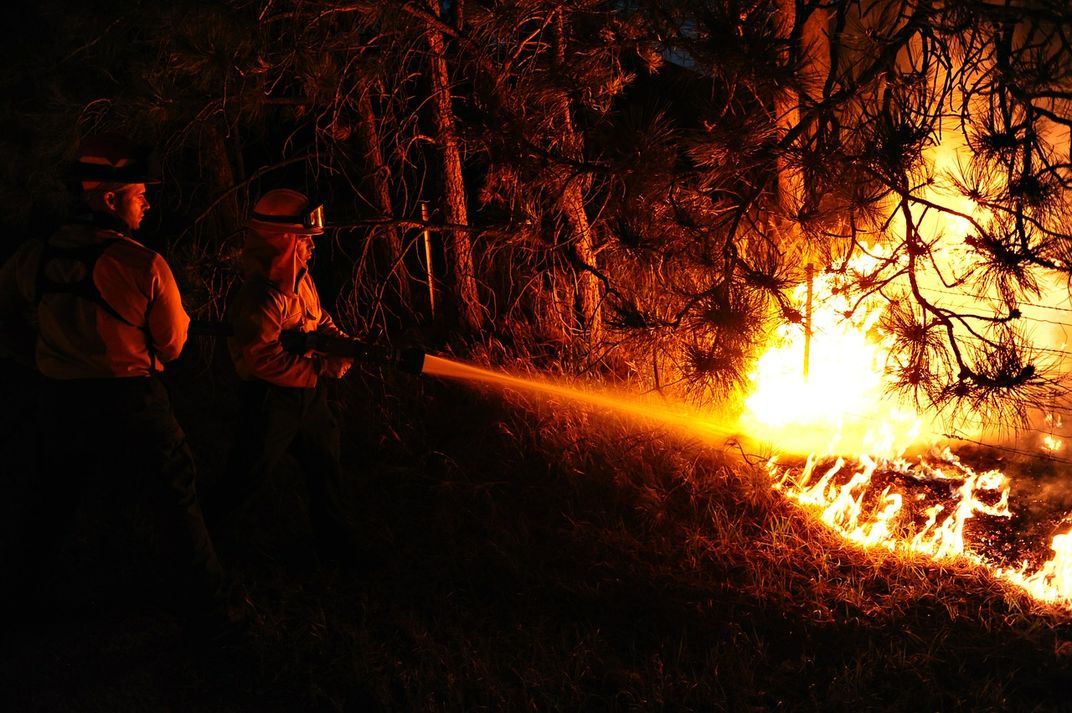Can Cypress Trees Help Suppress Wildfires?
Researchers in Italy and Spain suspect that cypress tree barriers could diffuse forest fires
/https://tf-cmsv2-smithsonianmag-media.s3.amazonaws.com/filer/b9/8f/b98f4d6f-cca4-4b1b-9bba-eac495f00760/cypress_trees.jpg)
It’s been a brutal summer for wildfires in the American West. In the hottest year to date, flames are bearing down on northern California, western Washington has scorched, and more than 5 million acres burned across Alaska.
As the wildfires smolder, across the pond, researchers from Italy and Spain are looking at a particular tree's natural resistance to fires, and how that might be used to temper these disasters. They have found that cypress trees ignite seven times slower than other tree species that are native to the same area.
“The peculiar flammability traits of cypress are not a real mystery,” says Gianni Della Rocca, the lead author on the study published in the Journal of Environmental Management. “The physical, chemical and biological characteristic of this species makes it not immediately prone to fire. It means that cypress burns, but it takes longer to catch fire than other Mediterranean species.”
The group conducted a series of tests on the Cupressus sempervirens species, which is native to the Mediterranean. In a lab, at the particle level, Della Rocca says, “a wide set of bench-scale calorimetry techniques were used to test the flammability parameters of live crowns and litter samples.” Then, in the field, they planted live green barriers. They will test the barrier's fire resistance as soon as the trees mature, to see if what they found in the lab holds up in the wild.
Across the board, all the characteristics they saw in the cypress trees indicate that they’d help fight wildfires of moderate intensity. The tree's needles and dead litter that falls to the ground are spongy and hold water for a long time, for one. The widely-spaced structure of the tree’s crown slows down air circulation, and the space between its branches reduces the speed at which a fire spreads. Cypress sap also happens to be less flammable than the resin from other trees.

The scientists started the research project after a destructive large-scale fire in Valencia, Spain, in 2012. That fire burned almost 50,000 acres, but less than 2 percent of the cypress trees in the region burned.
The trees are resilient and can grow in a range of soils, so Della Rocca and his colleagues suspect that they could be used to slow down and diffuse fires in a variety of settings. It might make sense to plant the conifers in California and other high and dry places that have been experiencing periodic fires, because the trees are hardy and can grow at altitude. It’s not as simple as planting seedlings in sensitive areas though. Anytime you introduce a non-native plant you risk damaging the native ecosystem. The species of cypress the group looked at is native to the Mediterranean, but Della Rocca says his team is doing additional tests to study the trees' effects in non-native regions.
To avoid crowding out native species and breeding unhealthy trees, cypress trees can be planted as a barrier along roads and properties or on the edges of urban areas, but Della Rocca says it's important how you plant. He wants to be clear that they’re not advocating for shrubs or neat hedges of cypress trees. For the trees to be effective, they have to grow at random as they normally would in the wild, so they can develop crown structure and litter piles in the same way. They’re experimenting now with how to grow these barriers.
“When we consider the cypress trees as a potential barrier able to reduce or slow down the fire initiation risk, we’re referring to multiple-row plantations with homogenous structure made by selected healthy and vigorous plants,” Della Rocca says.
/https://tf-cmsv2-smithsonianmag-media.s3.amazonaws.com/accounts/headshot/DSC_0196_2.JPG)
/https://tf-cmsv2-smithsonianmag-media.s3.amazonaws.com/accounts/headshot/DSC_0196_2.JPG)